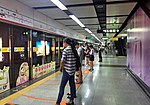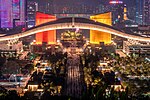Futian station

Futian station (Chinese: 福田站; pinyin: Fútián Zhàn; Jyutping: Fuk1 Tin4 Zaam6) is a station on the Guangzhou–Shenzhen–Hong Kong Express Rail Link, and the final station in mainland China before trains enter Hong Kong. Futian District is in southern Shenzhen, where the central business district is located. The station opened on 28 June 2011 serving the Shenzhen Metro, and since 30 December 2015 it has been the first underground high speed railway station on a long-distance line in China. It serves as an interchange station between the Guangzhou–Shenzhen–Hong Kong Express Rail Link (simplified Chinese: 广深港高速铁路; traditional Chinese: 廣深港高速鐵路) and Line 2, Line 3 and Line 11 of the Shenzhen Metro.The first level underground is a concourse for reaching both the metro trains and the high speed intercity trains. Passenger lounges and customs and immigration facilities are located here. The second and third underground levels serve Shenzhen Metro trains. At the fourth underground level are the platforms for China Railway High-speed (CRH) intercity trains arriving from Guangzhou and cities farther along the line.
Excerpt from the Wikipedia article Futian station (License: CC BY-SA 3.0, Authors, Images).Futian station
Fuhua 1st Road, Futian District Futian Sub-district
Geographical coordinates (GPS) Address Nearby Places Show on map
Geographical coordinates (GPS)
| Latitude | Longitude |
|---|---|
| N 22.538333333333 ° | E 114.05666666667 ° |
Address
大中华国际交易广场
Fuhua 1st Road 1
518048 Futian District, Futian Sub-district
Guangdong Province, China
Open on Google Maps











